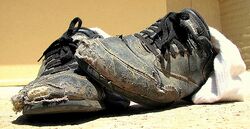
Overview[edit | edit source]
Globalization has made it easy for people in the developed world to ignore supply chains and sweatshop practices when it comes to shoes, among many other products. However, a shoe is still a significantly larger item to throw in the landfill when worn than a toothbrush. One way to slow down or prevent industries from exploiting workers or polluting is to make conscious purchases and stop contributing to irresponsible corporate practices.
The purpose of this web page is to compile information about the social justice and environmental impacts associated with shoe manufacturing in order to make it easier to make more informed shoe purchases. Several companies make a conscious effort to monitor a responsible supply chain, reduce waste, save energy, or reduce consumption of natural resources and production of harsh toxins. Here we are attempting to compile the available options and links to further information.
Also, in order to make this information useful for people in the developing world aswell, we should include several types of shoes. For example, minimalist shoes fit better in regions where little (and sometimes) no footwear is worn. In such regions, people tend to prefer footwear which they are more accustomed to, yet perhaps offer better foot protection than what they normally wear.
In other regions (ie non-arid regions), where thorny vegetation, swamps and/or dangerous insects prevail, more durable footwear may be preferred (ie regular shoes, army boots,...)
Materials[edit | edit source]
Knowledge of materials used in shoe production can be a useful tool when making decisions about shoe purchase.
Common materials used to make shoes include:
- rubber
- plastics
- leather, composition leather and fur skin
- textiles - including felt and nonwovens
- plaiting materials
- wood
- cork
Companies selling ecologic shoes (traditional style)[edit | edit source]
Some companies with a conscious approach to shoe making:
An overview of the companies is given in the following table:
| Shoe Brand / Type | Country of Manufacture | Materials | Material Impact | Manufacturing Impact | Recycling Options |
|---|---|---|---|---|---|
| Nike | global chain with over 900 contract factories around the world[1] | - ranks in top three "climate friendly companies" according to Clean Air-Cool Planet[2] | - favors recycled materials | - working to reduce/eliminate unfair labor practices within supply chain | - Nike Grind |
| Crocs | -Canada and Mexico
|
- Croslite: Developed exclusively for Crocs[3] | - Low recycling rate
|
*** | - Soles United |
| Macbeth | - China (nonsweatshop) | - Textile Upper
|
*** | *** | |
| TOMS | - China, Ethiopia and Argentina | - sustainable and vegan materials: currently includes natural hemp, organic cotton, and/or recycled polyester | - pesticide free textiles | "We clearly define appropriate business practices for our employees and hold them accountable for complying with our policies, including the prevention of slavery and human trafficking within our supply chain." manufacturing practices | *** |
| ReKixx | - unknown | - special blend of lab certified 100% recyclable materials | - landfill free | 100% recyclable | can be mailed back to company and reused for new product |
| Oat shoes | - unknown | - 100% biodegradable | - biodegrades 90% in 6 months when buried
|
* | biodegrades |
Companies selling ecologic shoes (minimalist style)[edit | edit source]
- Vibram (ie Vibram FiveFingers)
- Terra Plana (ie Terra Plana EVO)
- Nike (Nike Free)[6]